SoundWeather
Introduction
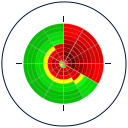
Weather reports are among the most frequently heard news broadcasts. They are just as important for planning activities for the next few days in the leisure sector as they are for many commercial activities. It is important to know whether it will rain or snow tomorrow, how strong the wind will be, or what temperatures can be expected.
The forecast of the pollen count is in the second row compared to the above-mentioned basic weather data, because it is not of fundamental importance for all people; nevertheless, it is a valuable offer of the weather services.
How ‘loud’ it will be tomorrow is not (yet) part of the standard offer of the weather services. Yet it is certainly interesting to know whether tomorrow will be a particularly favourable (loud) sound propagation situation or just not.
Such a forecast is the so-called sound weather; a prediction of the characteristics of the sound propagation conditions based on predicted atmospheric conditions.
On a weather map, the sound weather can be displayed just as strikingly as temperatures, cloud cover or precipitation. So-called noise roses are used for this purpose.
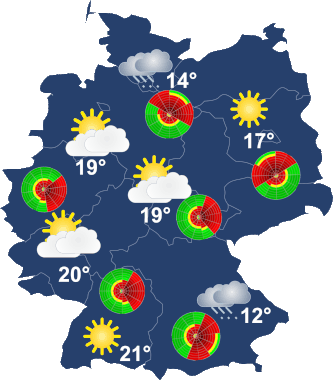
Noise rose
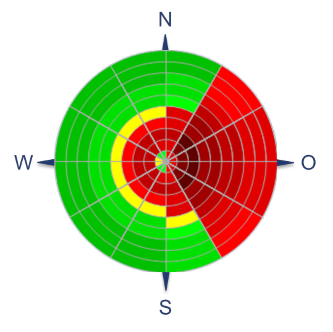
The word ‘noise rose’ has a lot to do with the word ‘wind rose’. A noise rose indicates which sound propagation is to be expected:
the redder, the louder
the greener, the quieter
yellow, somehow in between
The noise rose is relative. It says something about whether it will be louder or quieter than ‘normal’. Normal’ here means the propagation of sound without the influence of wind and temperature. The noise rose shown here indicates that a sound source will be heard much better (red areas) in the east than in the other directions.
A noise rose shows, depending on angle and distance, the classified and correspondingly colour-coded difference between the level in the current weather situation and the level in a neutral atmosphere.
The noise rose shown above is a realistic situation. It is ‘source-related’; i.e. the sound source is located in its centre. In conjunction with the colour coding, it becomes clear that levels can indeed change drastically. In this example, we are dealing with a typical sound propagation determined by wind: There is a westerly wind, which increases with height, so that the sound rays towards the east (red area of the noise rose) are bent towards the ground, while the sound rays towards the west are bent upwards, away from the ground. There, the levels are significantly lower; this is expressed by the green area in the noise rose.
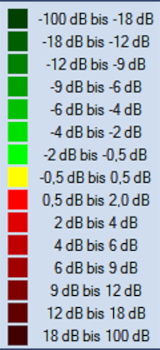
Sound propagation
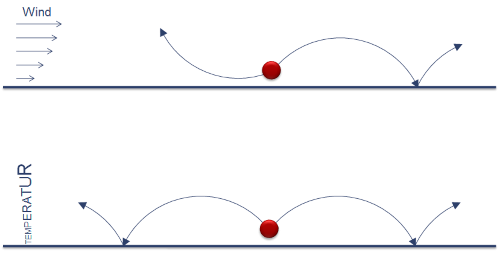
Popular ideas about sound propagation outdoors are seemingly plausible: “It is louder downwind than upwind” or “The sound is reflected by the clouds”. If you look at the phenomena from a physical point of view, these statements are not correct. It becomes ‘louder’ or ‘quieter’ because of the refraction of sound in the atmosphere: the atmosphere acts like a lens. This lens can refract the sound upwards (away from the earth’s surface = ‘quieter’) or downwards (back towards the earth’s surface = ‘louder’). An even wind, however, does not refract; it only changes the transport speed of the sound. A uniformly thick window pane also does not refract the light when it falls through vertically; the glass only changes the transport speed of the light. Only when lenses made of glass are ground does the glass body focus or defocus the light. Only when the wind speed increases (refraction downwards) or decreases (refraction upwards) at different altitudes does the atmosphere act like a sound lens. And it is true: as a rule, the wind strength increases with altitude, so it is louder downwind than upwind.
But it is not only the wind that turns the atmosphere into a lens. Temperature can do that too. When it gets colder with increasing altitude, the sound is refracted upwards: It becomes quieter, like a headwind. If it gets warmer with increasing altitude, the sound is refracted downwards. It becomes louder, as with a downwind.
The interaction of both phenomena determines the actual sound propagation. In low wind situations the temperature rules, otherwise the wind. Mostly, however, they form a ‘coalition’ that determines the loud and the quiet depending on the distance between the source and the receiver.
Sound refraction
Sound propagation outdoors depends on the height profile of the wind and the temperature. An altitude profile always indicates the dependence of the parameter on the height above ground. The temperature profile thus indicates how the temperature changes. The wind profile has two components: the wind speed and the wind direction. Both change with altitude.
For a current prediction of sound propagation, i.e. for calculating the noise rose, one therefore first needs a forecast of the two height profiles (wind, temperature).
Meteomedia profile forecasts
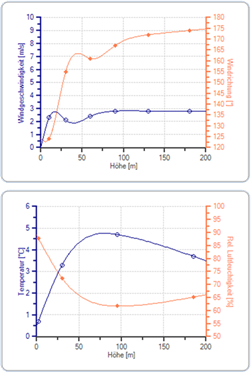
At our suggestion, ‘meteomedia international’ has developed the “profile forecast” service. meteomedia international belongs to the MeteoGroup, currently the largest private provider of weather services in Europe with the densest measurement network in Germany and Switzerland.
On the basis of two small-meshed weather models
- every 12 hours (at 0 o’clock and at 12 o’clock of each day)
- hourly specific for the next 48 hours
profiles of the
- wind speed,
- wind direction,
- temperature,
- and relative humidity
are supplied.
The figure above shows the wind profile on the left and the temperature profile and humidity profile on the right. You can see a wind rotation and the increase in wind strength in the layers close to the ground. The temperature also increases near the ground (so-called inversion), but this reverses at higher altitudes. Since sound only reaches low altitudes at short distances between source and receiver, the change in wind and temperature has a very strong effect. At greater distances, the sound reaches greater heights. Then the lens effect is much smaller. Noise roses are therefore distance-dependent.
Circumstances of the sound propagation
The propagation of sound depends not only on the temperature and the wind, but also on the height at which the source and the receiver are located relative to the ground: Different ‘sound rays’ become effective in each case. The frequency composition of the noise also plays a role. The noise roses presented here apply to a typical stationary industrial source and a receiver on the 1st floor, so to speak. For a wind turbine, everything would be different: there, one would expect a source height of around 100 m or more, which would greatly change the noise roses.
The noise roses presented here are based on the following scenario:
- Source signal: pink noise 100 Hz to 8 kHz
- Source height: 4 m
- Receiver height: 4 m
- Humidity: 70%
- Soil: Grassy soil
Of course, the ground also plays a role because it can absorb sound and reflect it differently depending on the type of ground.
Reference sound weather
- Wind profile: constant
- Temperature profile: constant
- Radius of curvature: infinite (straight beams)
As explained before, a noise rose is relative. The reference sound weather is assumed to be the non-breaking atmosphere.
Sound weather forecasts
- Wind profile: profile forecast
- Temperature profile: profile forecast
- Radius of curvature: determined at a height of 100 m/(distance/5000 m)
Application of the sound weather
The sound weather is a tool
for immission forecasting
- computation of long-term statistics
- calculation of the cmet of DIN ISO 9613-2
- and much more
for noise management
- Control of the operation of a plant (operational noise mitigation)
- Complaint management
- Assessment of the effectiveness of noise control measures on an annual average
and of course popular science
- Weather report with sound weather
- Wind and temperature at higher altitudes
